In a series of postings in the summer of 2019, Bruce Bayer discussed the taxonomy of Haworthia retusa and related H. turgida, H. pygmaea, H. mirabilis, H. magnifica, H. emelyae, H. mutica, H. groenwaldii, H. floribunda. Here are supplement references. ~ Lawrence Loucka
H. retusa (L.) Duval in Pl. Succ. Hort. Alenc.: 7 (1809): Aloe retusa L. (1753). Lectotype, designated by Scott (1985): Illustration in Commelin, Horti Med. Amstelod. 2: t. 6 (1701). Epitype, designated by Breuer & Metzing (1997): Blikbonnie, E Riversdale, Dekenah s.n. NBG144772 (NBG).
retusa: with leaf-tips bent back thumb-like.
Rosette stemless, slowly or seldom proliferous, to 12cm φ. Leaves 10-15, turgid, rigid, with pronounced retused end-area, pointed tips, variously lined and windowed. Without surface spination and usually without spination on margins and keel. Colours brownish or green and seldom purpling. Inflorescence simple, robust, to 30cm. Flowers compacted on inflorescence, white with greenish-brown veins.
Plantae succulentae, in Horto Alenconio. (reprinted in Cactus Journal, 1939, vii, no. 4.) by Henri Auguste Duval (1809)
Caroli Linnaei Species plantarum (1753) … Aloe retusa
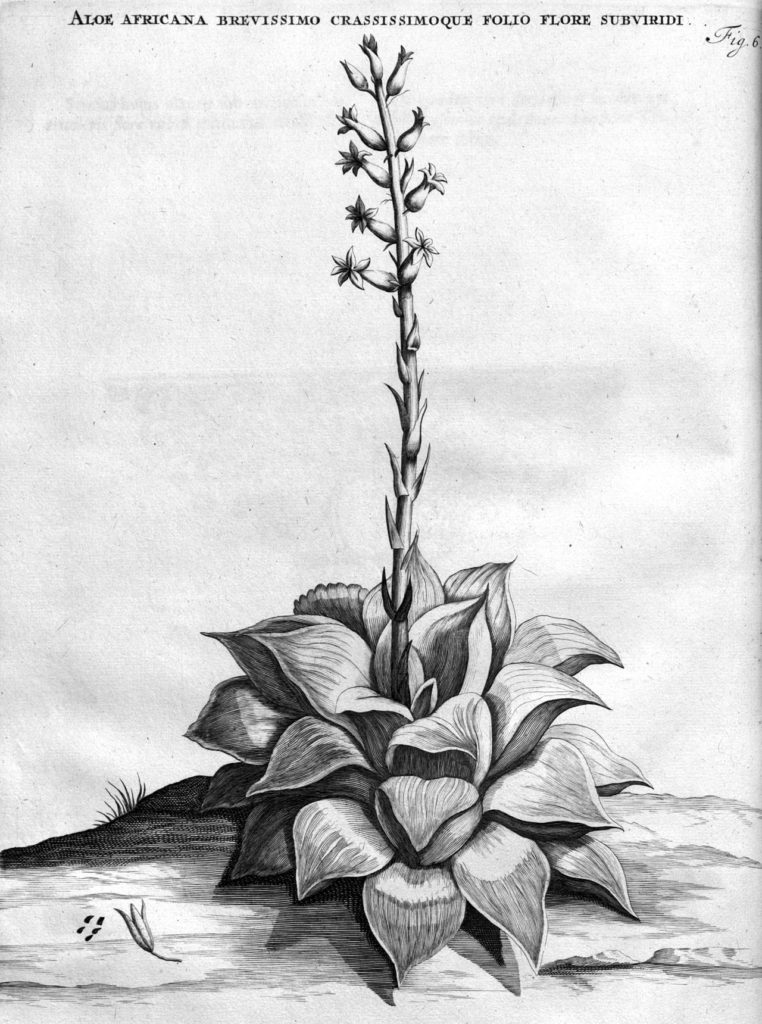
J. Commelin, Horti medici Amstelodamensis rariorum tam Orientalis, vol. 2: t. 6 (1701)
http://plantillustrations.org/illustration.php?id_illustration=122188
![Haworthia retusa (L.) Duval [as Aloe retusa L.]
Botanical Magazine (Curtis), t. 433-468, vol. 13: t. 455 (1799) [S.T. Edwards]
http://plantillustrations.org/illustration.php?id_illustration=7534](https://haworthiaupdates.org/wp-content/uploads/2019/07/H-retusa-2-665x1024.jpg)
Botanical Magazine (Curtis), t. 433-468, vol. 13: t. 455 (1799) [S.T. Edwards]
http://plantillustrations.org/illustration.php?id_illustration=7534
![Haworthia retusa (L.) Duval [as Aloe retusa L.]
A.P. de Candolle, P.J. Redouté, Plantarum Historia Succulentarum (Plantes grasses), vol. 1: t. 45 (1799-1837) [P.J. Redouté]
http://plantillustrations.org/illustration.php?id_illustration=48020](https://haworthiaupdates.org/wp-content/uploads/2019/07/H-retusa-3-778x1024.jpg)
A.P. de Candolle, P.J. Redouté, Plantarum Historia Succulentarum (Plantes grasses), vol. 1: t. 45 (1799-1837) [P.J. Redouté]
http://plantillustrations.org/illustration.php?id_illustration=48020
![Haworthia retusa (L.) Duval [as Aloe retusa L.]
J.S. von Salm-Reifferscheidt-Dyck [Salm-Dyck], Monographia generum Aloes et Mesembryanthemi, Aloe, vol. 1: , fig. 9.3 (1849-1863)
http://plantillustrations.org/illustration.php?id_illustration=184034](https://haworthiaupdates.org/wp-content/uploads/2019/07/H-retusa-4-702x1024.jpg)
J.S. von Salm-Reifferscheidt-Dyck [Salm-Dyck], Monographia generum Aloes et Mesembryanthemi, Aloe, vol. 1: , fig. 9.3 (1849-1863)
http://plantillustrations.org/illustration.php?id_illustration=184034
![Haworthia retusa (L.) Duval [as Aloe retusa L.]
Collection des vélins du Muséum national d’histoire naturelle, vol. 8: t. 63 () [C. Aubriet]
http://bibliotheques.mnhn.fr/medias/detailstatic.aspx?INSTANCE=exploitation&RSC_BASE=IFD&RSC_DOCID=MNHN_VEL_PORTEFEUILLE008_FOL063](https://haworthiaupdates.org/wp-content/uploads/2019/07/Aloe-retusa-751x1024.jpg)
Collection des vélins du Muséum national d’histoire naturelle, vol. 8: t. 63 () [C. Aubriet]
http://bibliotheques.mnhn.fr/medias/detailstatic.aspx?INSTANCE=exploitation&RSC_BASE=IFD&RSC_DOCID=MNHN_VEL_PORTEFEUILLE008_FOL063
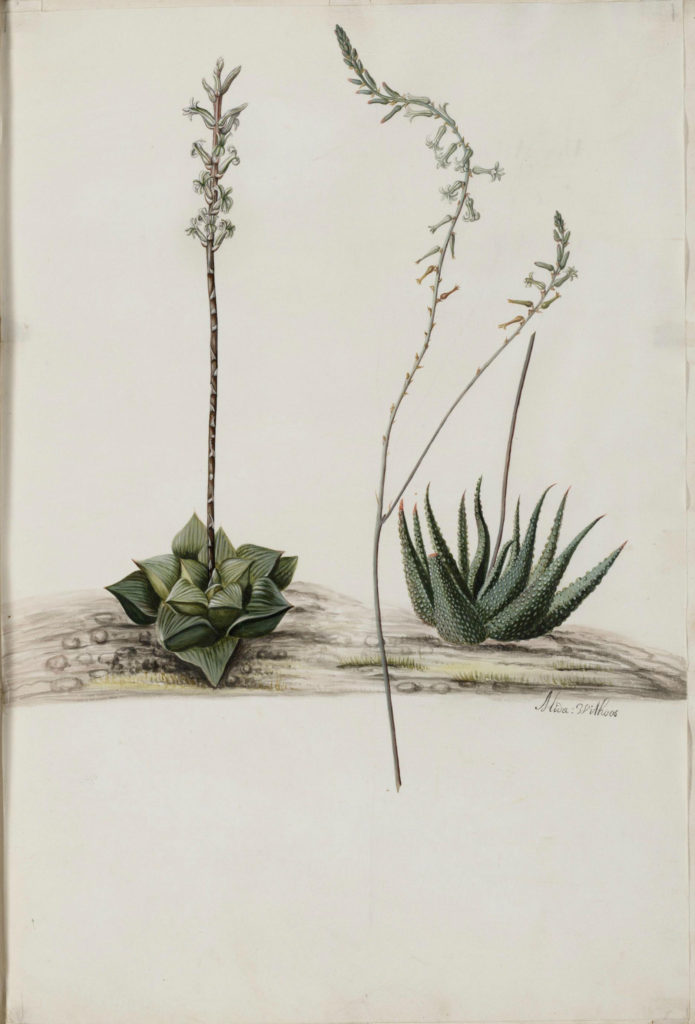
J. Moninckx, Moninckx atlas, vol. 3: t. 7 (1682-1709)
http://plantillustrations.org/illustration.php?id_illustration=138251
H. retusa var. turgida (Haw) Bayer (2012)H. turgida Haw. in Suppl. Pl. Succ.: 52 (1819). Neotype, designated by Breuer & Metzing (1997): Swellendam, Breede River Bridge, Bayer 2420 (NBG).
turgida: swollen.
Rosette partially stemless, proliferous, 5-10cm φ. Leaves 20-40, turgid often as thick as broad, recurved or slightly retused, generally mottled, yellow-green to pink in sun, margins and keel lightly spined. Inflorescence simple, 15-20cm. Flowers slender, brownish-white with darker venation.
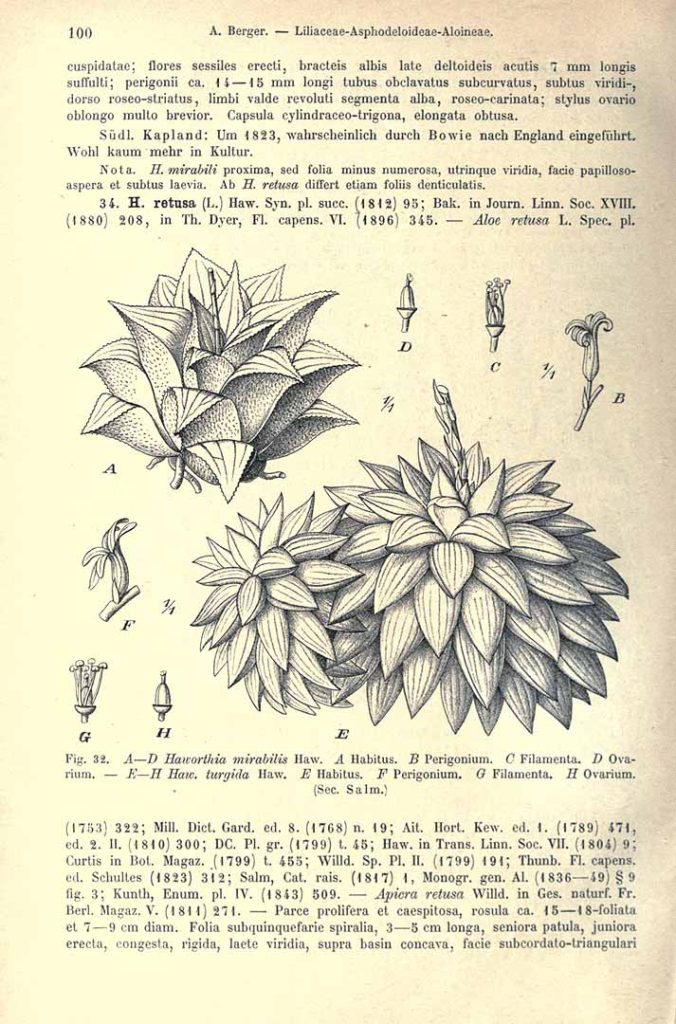
H.G.A. Engler, Das Pflanzenreich, Liliaceae – Asphodeloideae – Aloineae, vol. 38: [Heft 33], p. 100, fig. 32 E-H (1908)
http://plantillustrations.org/illustration.php?id_illustration=180601
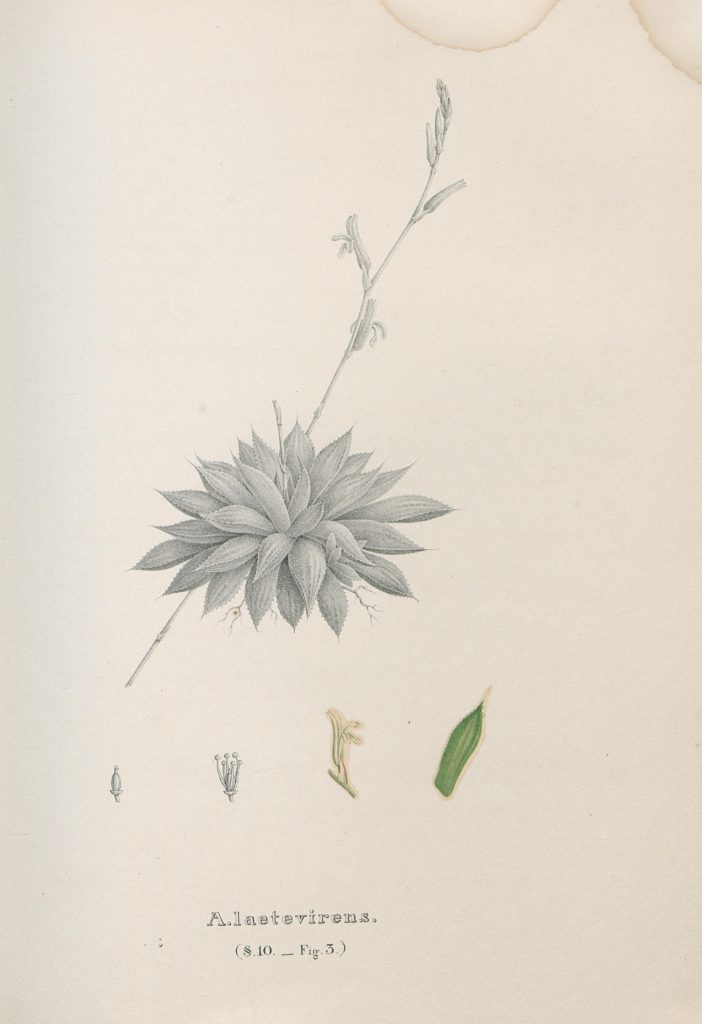
Haworthia turgida Haw. [as Aloe laetevirens (Haw.)]
J.S. von Salm-Reifferscheidt-Dyck [Salm-Dyck], Monographia generum Aloes et Mesembryanthemi, Aloe, vol. 1: , fig. 10.3 (1849-1863)
http://plantillustrations.org/illustration.php?id_illustration=184039
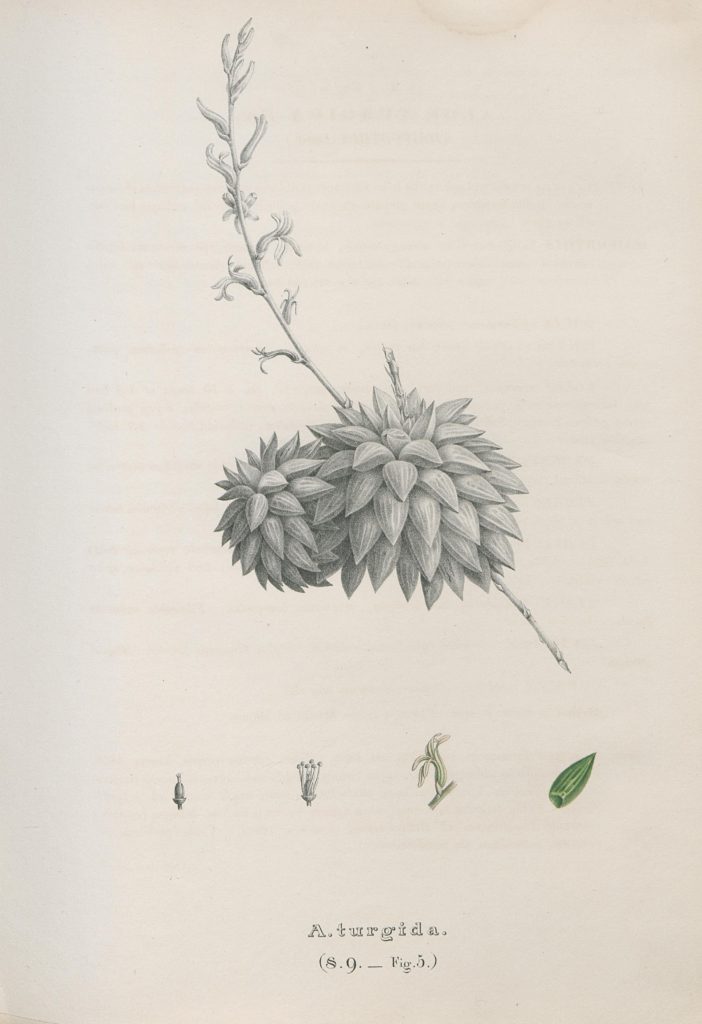
J.S. von Salm-Reifferscheidt-Dyck [Salm-Dyck], Monographia generum Aloes et Mesembryanthemi, Aloe, vol. 1: , fig. 9.5 (1849-1863)
http://plantillustrations.org/illustration.php?id_illustration=184036
H. pygmaea V.Poelln. in Repert. Spec. Nov. Regni Veg. 27: 132 (1930). Neotype, designated by Breuer & Metzing (1997): hills E Great Brak, Fourcade 4759 (BOL).
pygmaea: dwarf.
Rosette stemless, slowly proliferous, 6-10cm φ. Leaves 12-15, retused, round-tipped, surface pellucid with obscure raised tubercles, sometimes intensely papillose. Inflorescence simple, robust, to 30cm. Flowers white with greenish veins.

Repertorium specierum novarum regni vegetabilis. vol. 27, page 132.
https://bibdigital.rjb.csic.es/idurl/1/14723
H. mirabilis (Haw.) Haw. in Syn. Pl. Succ.: 95 (1812): Aloe mirabilis Haw. (1804). Neotype, designated by Bayer (1977): Illustration in Curtis’ Bot. Mag.: t. 1354 (1811). Epitype, designated by Breuer & Metzing (1997): Skuitsberg, between Caledon and Greyton, Bayer 2453 (NBG).
mirabilis: wonderful.
Rosette stemless, proliferous, to 7cm φ. Leaves 10-15, retused, 3-4cm X 1,5cm, markedly retused, acute above, face translucent and lined, dark green, with marginal spines turning reddish in the sun. Inflorescence slender. Flowers narrow, elongate, biarcuate bud, upper lobes pinched at tips.

H.G.A. Engler, Das Pflanzenreich, Liliaceae – Asphodeloideae – Aloineae, vol. 38: [Heft 33], p. 100, fig. 32 A-D (1908)
http://plantillustrations.org/illustration.php?id_illustration=179083
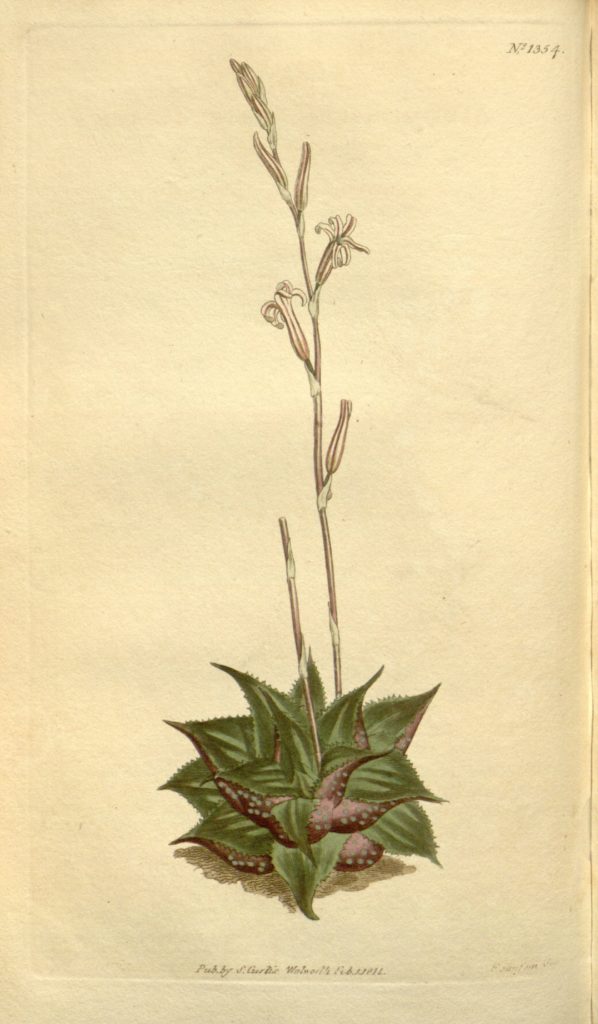
Curtis’s Botanical Magazine, t. 1329-1373, vol. 33: t. 1354 (1811) [n.a.]
http://plantillustrations.org/illustration.php?id_illustration=8347
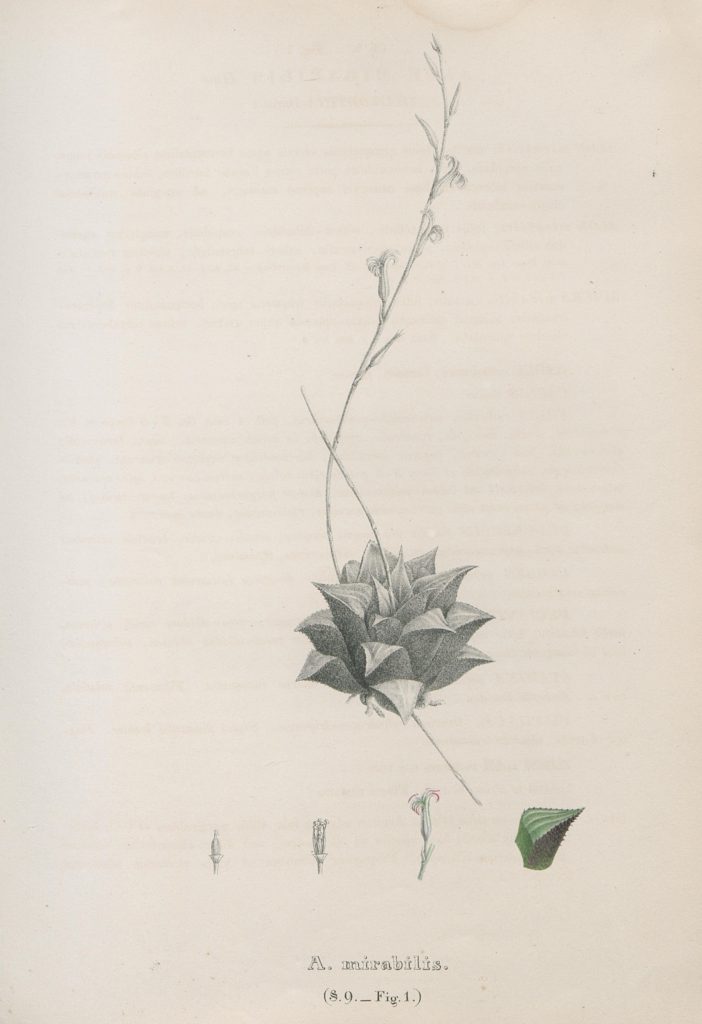
J.S. von Salm-Reifferscheidt-Dyck [Salm-Dyck], Monographia generum Aloes et Mesembryanthemi, Aloe, vol. 1: , fig. 9.1 (1849-1863)
http://plantillustrations.org/illustration.php?id_illustration=184032
H. mirabilis var. magnifica (V.Poelln.) Bayer (2012): Haworthiamagnifica V.Poelln. in Repert. Spec. Nov. Regni Veg. 33: 240 (1933): H. maraisii var. magnifica (V.Poelln.) Bayer : 131 (1976). Lectotype, designated by Breuer & Metzing (1997): Riversdale, Ferguson.
magnifica: magnificent.
Rosette stemless, slowly proliferous, to 8 cm φ. Leaves spreading, retused to ground level, dark green to purplish, scabrid to finely spined margins, end-area slightly translucent between the veins, surfaces with small slightly raised tubercles. Inflorescence slender, to 40cm. Flowers brownish veined, few open, upper lobes pinched at tips.
H. emelyae V.Poelln. in Repert. Spec. Nov. Regni. Veg. 42: 271 (1937). Lectotype, designated by Breuer & Metzing (1997): [unpublished image] (B).
emelyae: for Emely Ferguson.
Rosette to 10cm φ, seldom proliferous. Leaves 15-20, distinctly retused, pointed, barely translucent, with scattered elongate small flecks, with obscure raised tubercles, lined, reddish-brown hued. Inflorescence simple. Flowers 15-20, white.
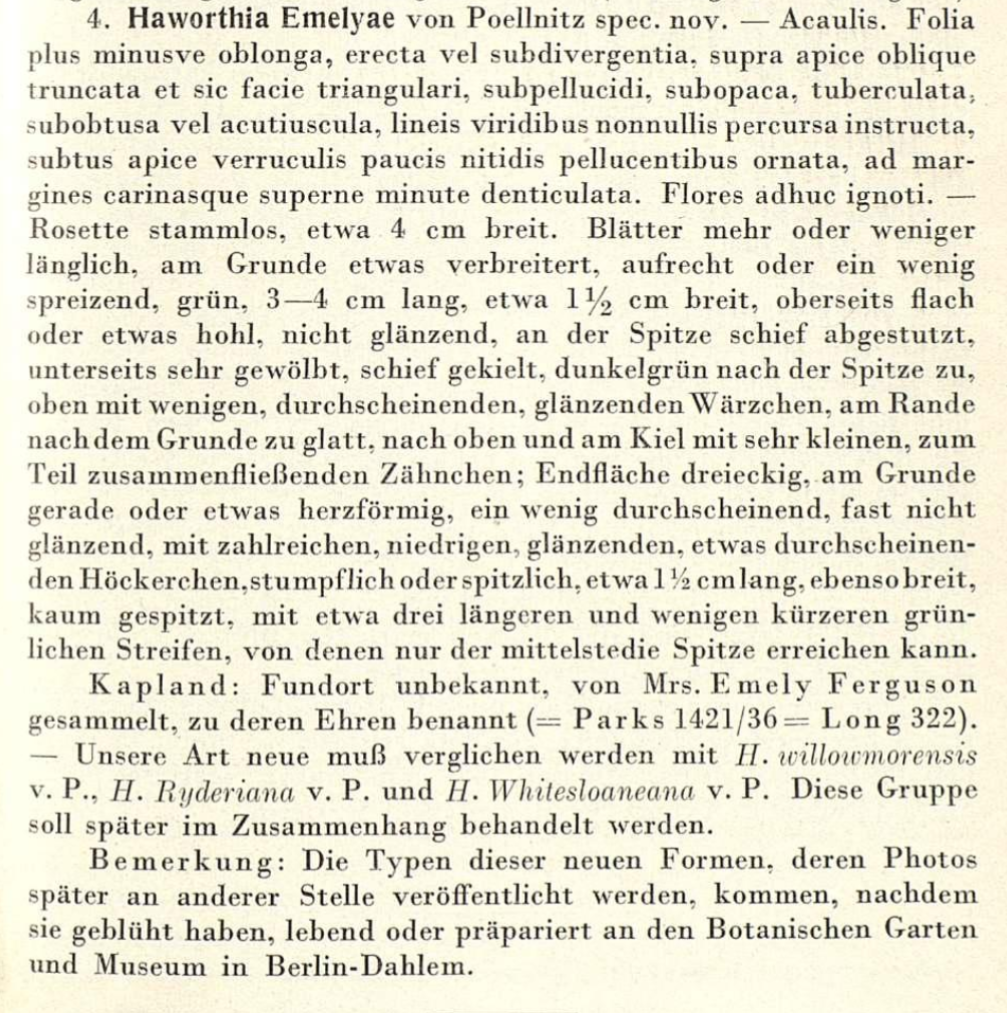
https://bibdigital.rjb.csic.es/idurl/1/14784
H. mutica Haw. in Revis.:55 (1821). Lectotype, designated by Bayer (1978): [image] (K; later published in Excelsa 8: 50 (1978). Epitype, designated by Breuer & Metzing (1997): NE Soetrivier Bridge, Bayer KG623/69 (NBG).
mutica: without a point.
Rosette stemless. non-proliferous, 6-8cm φ. Leaves 12-15, retused, blunt-tipped, brownish-green, in habitat developing purplish cloudiness, barely pellucid with several longitudinal lines. Inflorescence simple, to 20cm. Flowers white with brownish veins.
H. groenewaldii Breuer in Alsterworthia Int. 11: 15 (2011). = H. mutica
https://alsterworthia.files.wordpress.com/2015/07/alsterworthia-v11-2.pdf
Description: Always growing singly, but in a couple of cases growing in groups of plants of different ages. Rosette: acaulescent, 40-50 mm Ø (exceptionally up to 100 mm). Leaves: 5-7(8), fleshy, spreading, end-area in most cases very rounded (resembling H. springbokvlakensis), 20-25 mm long, 13-18 mm broad, 11-13 mm thick. Leaf surface of back and leaf-base, smooth, opaque; colour dull dark green. Margins: opaque, smooth. Back without keel. End-areas: 13-18 mm long, face translucent, with 3-5 whitish parallel lines, the middle one the longest (sometimes parallel lines are ± partly of greenish colour). Surface of the end area, rough with small papillae. End area of some specimens are with ± whitish, ± raised dots, in a few cases the dots are blended into cloudy flecks. Leaf-tip: very rounded, without teeth. Inflorescence: 300-600 mm long, 1.2-2 mm diam., Peduncle: 200-300 mm long. Sterile Bracts: 15-20, 5-7 mm long. Raceme: 100-300 mm long. 8-18 flowers, 2-5 flowers open at one time. Fertile Bracts: 3-4 mm long. Pedicels: 2-4 mm long, 1-1.2 mm diam. Flowers: 14-16 mm long. Perianth: 3 -4 mm diam. Flower-face: 9-12 mm long. Upper part: 6-7 mm long, 3-5 mm broad. Lower part: 5-7 mm long, 5-9 mm broad. Fruit: 11-18 mm long, 2.5-4 mm thick. Flowering time February–March. Type Information Collector: J. Groenewald s.n. (= MBB7801) Locality: 3420 (-BA), Buffeljagsrivier, Western Cape, SA.
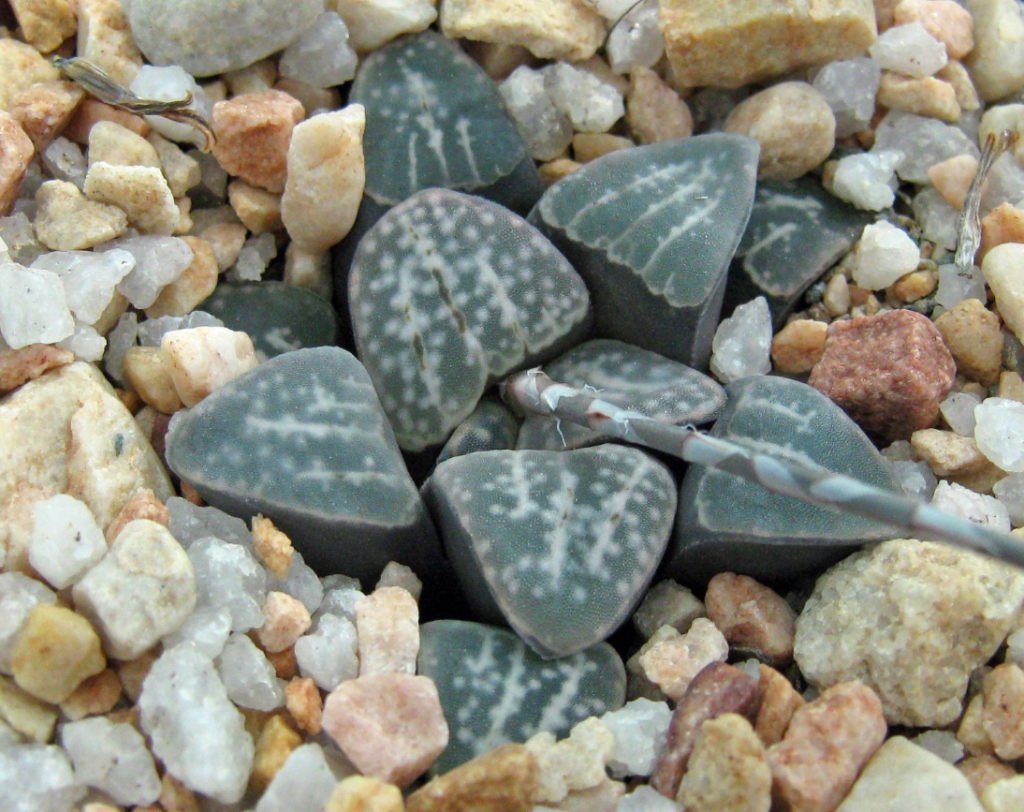
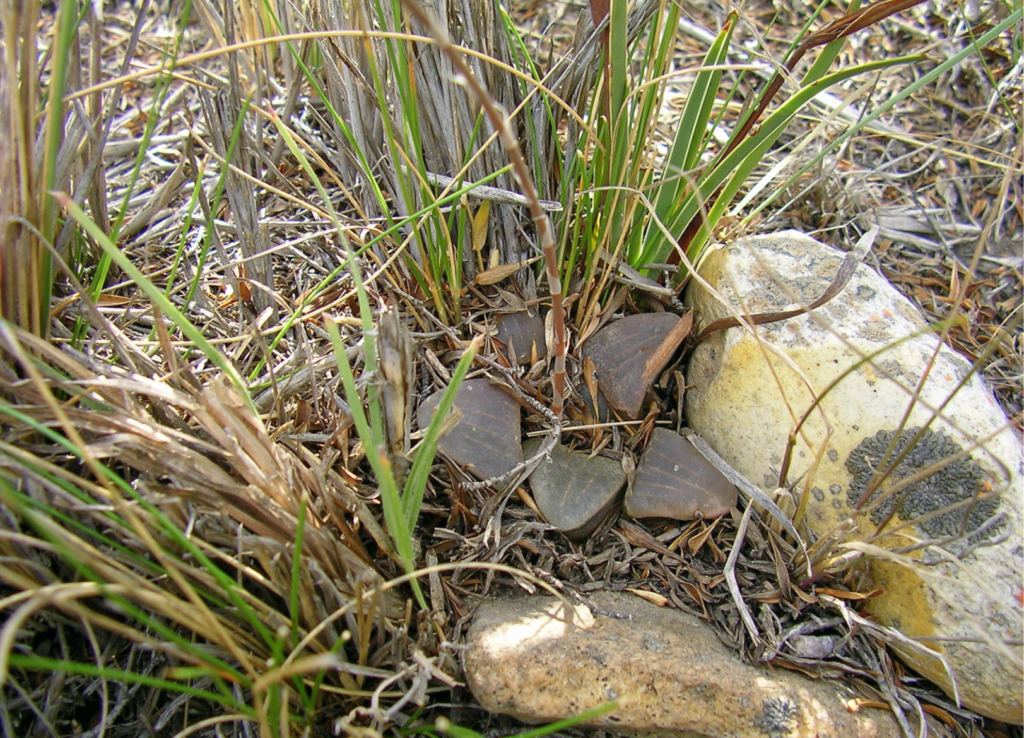
Haworthia groenewaldii in Habitat. Specimen without whitish flecks, growing in between Merxmuellera disticha, a hard and unpalatable grass.
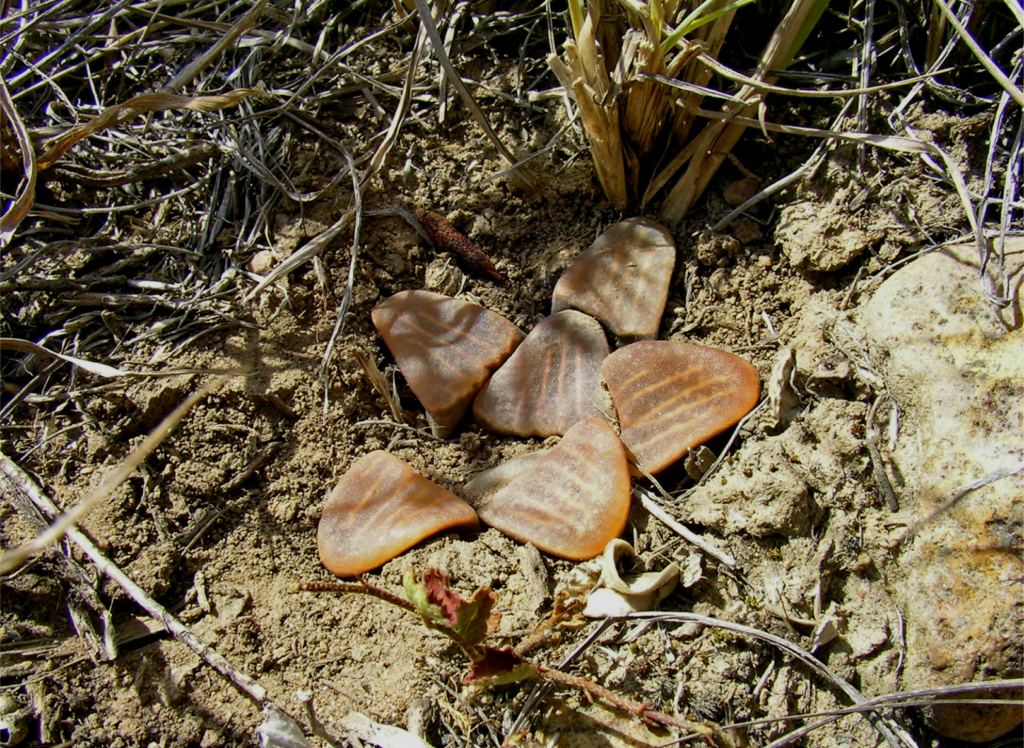
Another specimen of Haworthia groenwaldii with little whitish flecks

H. floribunda V.Poelln. in Repert. Spec. Nov. Regni Veg. 40: 149 (1936). Neotype, designated by Bayer (1982): [unpublished image] (B). Epitype, designated by Breuer & Metzing (1997): Blackdown, NE Heidelberg, Bayer 158 (NBG).
floribunda: many flowered.
Rosette stemless, up to 3cm φ, slowly proliferous. Leaves 20-30 dark green opaque, upto ovate-lanceolate, spreading, twisted with flattened, rounded tip, margins scabrid to dentate. Inflorescence simple, to 250mm. Flowers 10-15, greenish-white, few open together.
Repert. Spec. Nov. Regni Veg. 40:149
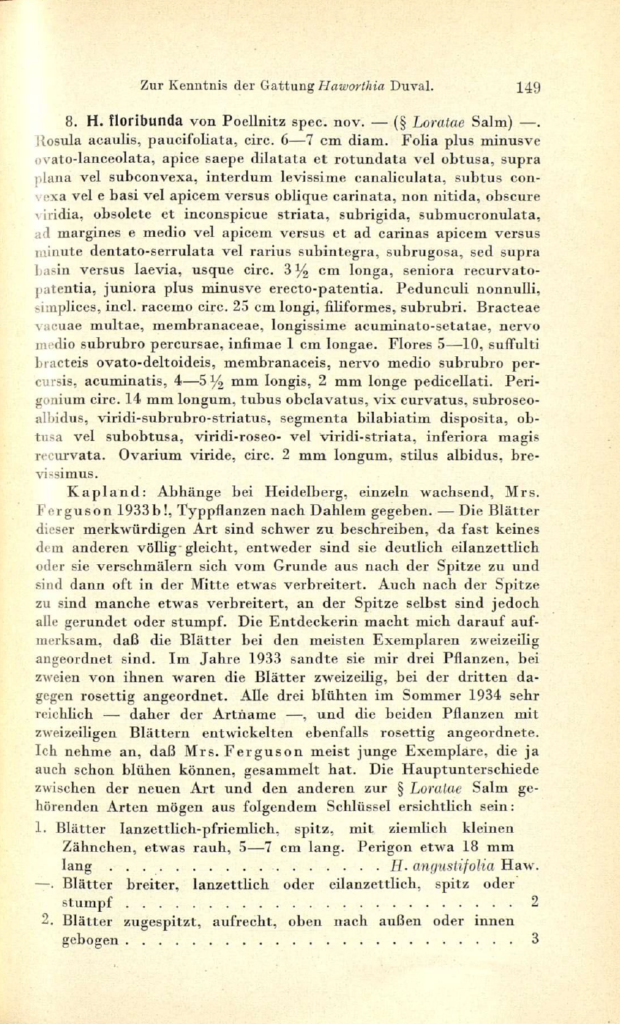
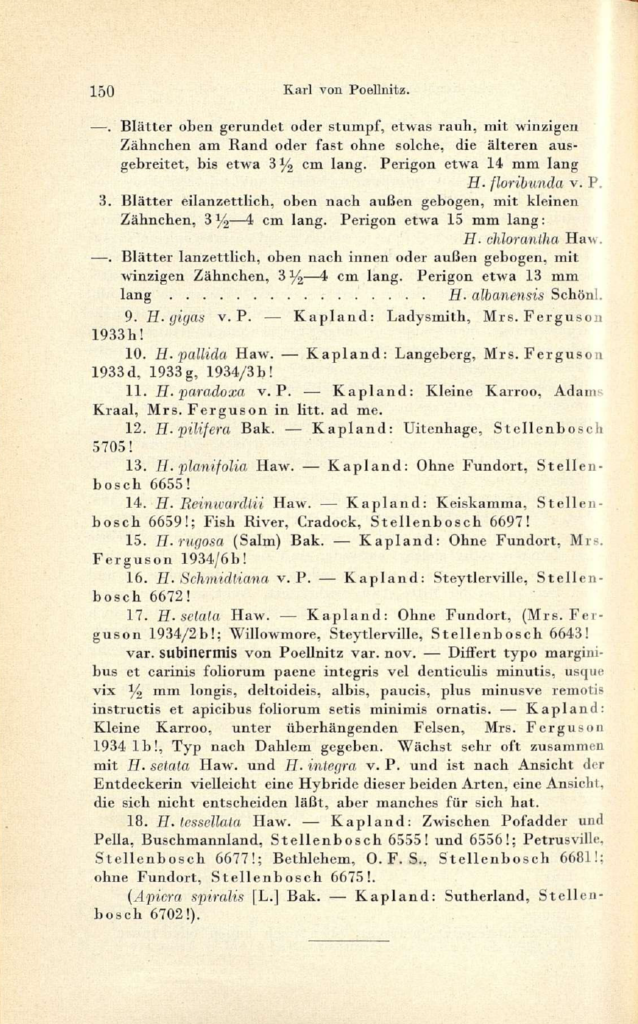
Other references:
- Journal of the Linnean Society vol 18 – 1881, J. G. Baker ‘On Aloinea and Yuccoidea’ – 3. Haworthia starting on 209 (page 197). H. retusa 220 (208). H. turgida on the next page.
- Enumeratio Plantarun – Liliaceae and Asphodeleae – C S Kunth 1843
- Repert spec nova regni veg 27 1930 v Poellnitz
- Synopsis of the Genus Haworthia Duval, with some nomenclatural changes (1997). Acta Musei Richnoviensis 4 (2) – Josef J. Hilda
♦
